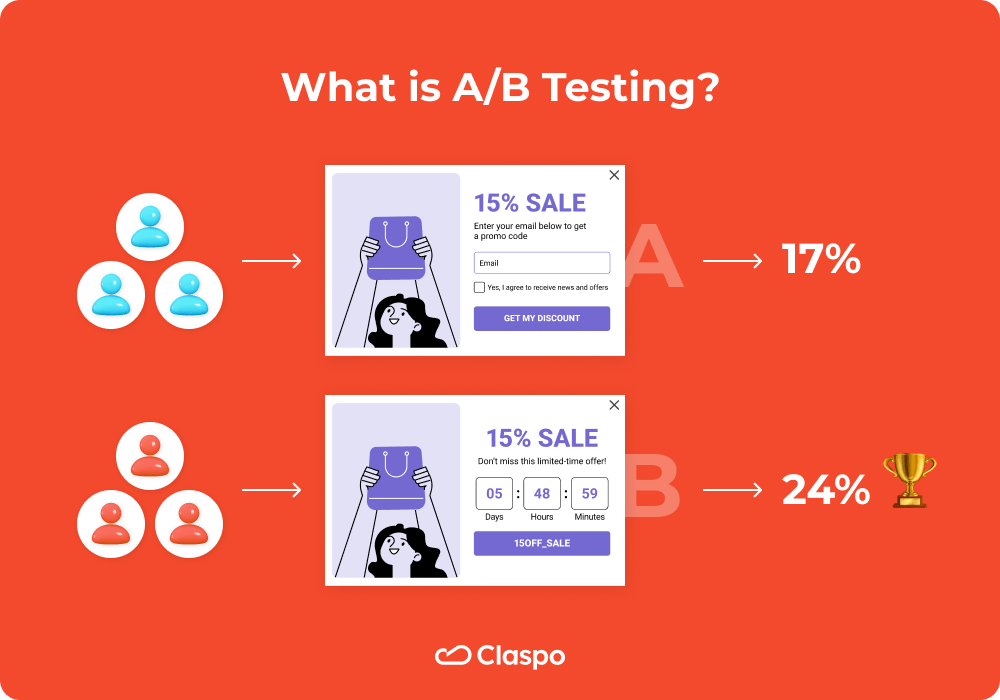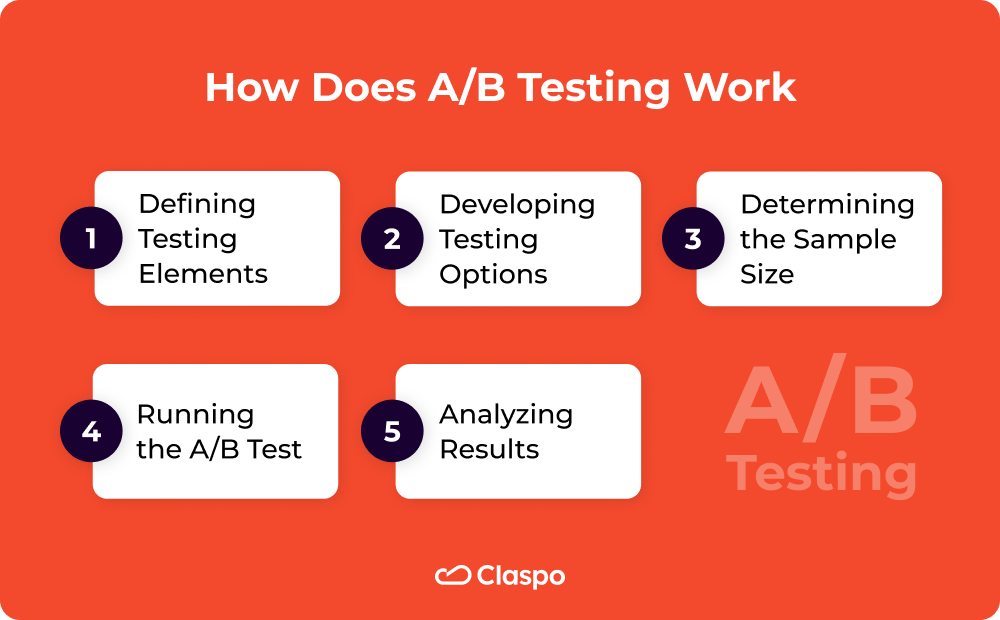What is A/B Testing: Steps & Best Practices
According to recent research, about 60% of companies already use A/B split testing, while 34% plan to use it in the future. The adoption of this approach is not surprising as it correlates with improved business outcomes like increased page views, more leads, and boosted revenue.
Using A/B testing for marketing allows you to make data-driven decisions by comparing two versions of a website’s page, email, or other marketing elements to see which performs better. For example, Veem Software made a test where they changed a single word in their CTA, leading to a 161.66% CTR growth.
In this article, we’ll share multiple examples and case studies to define A/B testing and provide you with all the required information regarding this approach.
What is A/B Testing?
A/B testing means comparing two versions of a website, landing page, email, or any other variables to see which one performs better. It involves showing two variants to similar visitors simultaneously and using statistical analysis to determine which variant leads to a more favorable outcome, such as higher conversion rates or increased engagement.
A/B testing, in its modern digital form, wasn't created by a single marketer: it evolved from statistical hypothesis testing and controlled experiments, principles that have been around since the early 20th century. The concept became popular in the online marketing and web development communities as Internet usage surged.
Google and Amazon were among the first major companies to adopt A/B testing extensively in the early 2000s to optimize website experiences and increase conversion rates. They significantly improved user engagement and revenue through iterative, data-driven changes and popularized A/B testing across industries.
Now, A/B testing is a standard practice for optimizing digital content, layouts, and marketing strategies, enabling organizations to make informed decisions based on direct evidence rather than intuition.

Why Should You Use A/B Testing?
A/B testing is highly regarded by experts for multiple reasons: data-driven decisions, increased conversion rates, continuous improvement, and an enhanced user experience. Testing various hypotheses allows companies to find the most profitable solutions and gain a competitive advantage.
1. Solving Pain Points
All users act with a certain intent:
- Analyzing content about a particular topic;
- Exploring available products and services;
- Learning more about a company’s offer;
- Purchasing the product or service.
Whenever users encounter an obstacle on their path, they are likely to switch to a competitor’s resource. For example, 53% of mobile users will abandon a website that takes more than 3 seconds to load. This causes lost traffic and potential clients during most steps of the sales funnel.
A case study by GoCardless, a British FinTech company, shows that changing a single word in their CTA increased product demo conversion by 139%. All they had to do was switch their CTA from “Watch a demo” to “Watch”, making the message simpler and more direct.

This proves that even the slightest details can impact your potential customer’s journey and business outcomes.
2. Increasing ROI
Investing in A/B testing can significantly increase your company’s return on investment by helping you make data-driven decisions. This optimization process reduces waste on ineffective designs or strategies, ensuring resources are allocated to the most impactful initiatives.
A case study by BigContacts, a CRM provider, shows that changing their price page layout and description led to a 76% increase in sign-ups for their free trial. The company switched to a more practical design focused on simplicity and clarity, improving their results.

If more people sign up for your product’s free trial, your chances of converting them into paying customers are much higher. That’s why using A/B testing properly may lead to substantial financial gains.
3. Achieving Statistically Significant Results
A/B testing is designed to produce statistically significant results, offering a clear understanding of whether changes positively or negatively affect user behavior. This ensures all the gained insights are reliable and actionable. Focusing on data instead of intuition allows you to make changes confidently, reducing the risk of making detrimental changes and leading your business to more successful outcomes.
Expert advice from Taras Talimonchuk, CMO at Claspo:
“When planning your A/B test, I recommend first identifying different audience segments. Take, for example, testing which call to action leads to higher conversions on a webpage receiving both organic and paid traffic equally.
The audience coming from organic searches may look for insights into a problem, whereas visitors from paid ads may be interested in concrete solutions. To effectively convert these distinct groups, you'll need tailored CTAs. For organic traffic, a CTA like "Get the latest research insights on {the problem} for free" works well. For the paid traffic, "Discover winning solutions to {the problem} from top e-commerce marketers" might be more effective.
Without segmenting your traffic, your A/B test may yield statistically significant results but fail to provide meaningful marketing insights. Testing these CTA versions on both segments, in turn, likely won't lead to meaningful changes or outcomes.”
Basic Elements for Your A/B Test
Our team at Claspo specializes in creating high-converting pop-ups for websites. We’ll provide you with the essential elements for A/B website testing. You’ll see what can be tested and the possible outcomes to plan your A/B test.
Note that it’s important to test your elements following a “one at a time” principle to get measurable results.
1. Pop-up Windows
If your website doesn’t use pop-ups, you could try adding them to analyze their impact on conversions. Our collaboration with Devart is a perfect example. We added pop-up windows to the most viewed pages with low conversion rates in an attempt to convert as much traffic as possible. The results led to a 48% increase in product downloads and a 26.7% growth in conversion rates.
2. Headlines
Headlines are the next element to try out in your A/B split test. They greatly impact user engagement and retention, as most users usually scan the information and focus on headlines instead of reading all the texts in detail. A case study by Monthly1K, an app for entrepreneurs, demonstrates how they changed their main headline and received a 6.5% increase in sales.
3. Graphic Elements
94% of first impressions and overall perceptions of your website depend on design. The same relates to all other resources and marketing materials. You can experiment with different visuals, photos, colors, and designs as long as you have a hypothesis to test.
4. Navigation
If your website is difficult to use, people are unlikely to keep on using it. This means you should experiment with different user journeys and find an optimal way to place all the navigational elements. A case study by WallMonkeys, an e-commerce business, showed how they increased revenue by 550% after adding a search bar to their homepage. They simplified navigation for their users and this generated a bigger profit.
5. CTA
Your call to action is one of the most important elements in any resource, as it’s usually the final push to converting a lead into a customer. That’s why you should experiment with different wording in your CTAs, as even the slightest change can affect user behavior. For example, Humana, an American healthcare company, increased banner click-throughs by 433% after changing their CTA.
Popular A/B Testing Methodologies
There are many different A/B testing methodologies to help you find the best versions that lead to the most profitable results. We’ll show you the three basic ways to conduct an A/B test with your website.
1. Split URL Testing
Split URL testing is a method used in web development and digital marketing to compare the performance of different versions of a web page or website.
In this approach, traffic to a URL is split between two or more versions of a page, which are hosted on different URLs. This testing allows you to analyze how different designs, content, and features affect user behavior and conversion rates.
Split URL testing is usually used for significant variations, such as a complete redesign or major layout changes. It’s quite useful when the changes are too big to be executed within the same framework and provides you with effective insights into the changes in sales, sign-ups, and other goals.
2. Multivariate Testing
Multivariate testing is a method used to evaluate the performance of multiple variations of several elements on a webpage simultaneously to determine which combination produces the best outcome.
It allows you to conduct a more detailed analysis by testing changes to multiple elements: headlines, images, call-to-action buttons, and others. You’ll understand how different elements interact with each other and affect conversion rates.
Multivariate tests are useful for optimizing websites to improve specific metrics like click-through rates, sign-ups, and purchases. Analyzing the results of various combinations allows marketers to identify the most effective version of the website, although it requires a significant amount of traffic to achieve statistically significant results.
3. Multipage Testing
Multipage testing is a method used in digital marketing and website optimization to test variations across multiple pages of a website simultaneously. This approach allows you to understand how changes on one page affect user behavior further down the funnel, such as from a landing page to a checkout page.
It's most useful for optimizing the user journey and ensuring consistency across different stages of user interaction with the website. You’ll examine the user experience across several pages to improve the overall user flow and conversion rates.
Multipage testing requires a lot of analytical work because it acknowledges that the performance of one page can influence the performance of subsequent pages. This makes it essential for comprehensive website optimization efforts. It allows you to make informed decisions to enhance the overall user journey.
A/B Testing Examples
Let’s check out several A/B test examples to see their benefits for well-known global businesses.
1. Crossrope
Crossrope, an American fitness equipment manufacturer, tested using a pop-up with a final offer for visitors about to leave the website. Adding a special discount for these users led to a 7.65% bounce rate reduction, allowing the company to maintain potential customers on its website.

2. Netflix
Netflix, an American streaming service, created its famous personalization algorithm using an A/B test study with a sample size of over 100,000 users. While the results are hard to measure in specific numbers, the company’s approach is considered one of the best practices in A/B testing. It brought millions of new users and billions of dollars in revenue due to a personalized experience that meets every user’s needs.

3. Airbnb
Airbnb, an American homestay listing company, used A/B testing across various experiments to engage new users and increase revenue. While the company doesn’t share specific numbers and outcomes, it constantly experiments with new approaches and analyzes the results. This led to the company becoming a leader in its niche with nearly no competition.

How Does A/B Testing Work: 5 Steps
The A/B testing process consists of five general steps that include certain goals and expectations. As we already described the detailed planning process in our “How to Plan A/B Testing” article, we’ll provide you with a general overview of the whole process. You can also check out our blog for more content covering A/B testing from A to Z.

1. Defining Testing Elements
Ask yourself, “What do I plan to improve?” You will probably have to conduct a marketing audit with your in-house team or an outsource partner to identify potential areas for improvement.
Let’s imagine that you’re working with an e-commerce website and determined that one of your product pages has a low conversion rate due to the absence of a clear motivator to buy.
2. Developing Testing Options
Ask yourself, “How can I improve the situation?” You will have to create an A/B test where Test A would be the page’s old version and Test B would include an update.
Let’s suppose that you have a hypothesis that adding a pop-up with a coupon code would increase the conversion rates on this page. You can use Claspo’s testing module to integrate one of our 700+ templates or create a custom pop-up and test its performance.
3. Determining the Sample Size
You need an adequate sample size to ensure statistical significance. Julian Shapiro, a marketing professional, recommends using the exponential law. This means that 10,000 visitors in the control group are needed to confirm a 2% change in the target, and 1,000 users are needed to confirm a 6.3% or more change in the target.
For instance, conversion rates are expected to change by 50%. With this in mind, 1,000 visitors will be enough to sample the alternative version of the product page with pop-ups. Note that this is a very simplified calculation, and it should only be regarded as an example.
4. Running the A/B Test
Now, you should equally split traffic to the product page’s variants A and B, ensuring each visitor is consistently shown the same version to maintain test integrity. The test runs over several weeks, with your team closely monitoring to ensure enough data is collected according to the predetermined sample size and that any technical issues are addressed promptly to avoid affecting the results.
Claspo’s A/B testing module can help you evaluate the impact of each pop-up on conversion, engagement, and the number of leads. Google recommends conducting A/B testing for two weeks or until you obtain a 95 percent probability of confirming the hypothesis. That’s when your study will be considered successful.
5. Analyzing Results
After concluding the testing period, your team should analyze the data to compare the performance of the original elements against the new variations. If you doubt the current results, you can perform an additional test to confirm them.
You can try testing other elements like CTAs, headlines, layouts, and anything that comes to your mind to improve your website’s performance. It’s a continuous process that has no limits. The main thing is to keep this process consistent and use the data from the last experiment as a springboard for subsequent ones. Our A/B testing template will help you with this. It contains the key steps and sub-steps that must be considered when validating any hypothesis.
How Can Claspo Help?
At Claspo, we're passionate about A/B testing and regularly share insightful findings on its use and analysis (this article is great proof). But our help extends beyond theory to practical application. Our builder enables you to experiment with various aspects of your pop-ups, including layout, design, placement, timing of appearance, headline, offer, call-to-action (CTA) button, and much more. And with our integrated analytics, you can monitor the essential performance metrics of your pop-ups in real-time, throughout the testing phase and after completion.
So what to do now?
Use our A/B testing template to jot down your widget-related hypotheses, implement them effortlessly with our builder, and then revisit the template to record and assess the outcomes for informed decision-making.
You can begin with Claspo's free lifetime plan and only consider upgrading when your strategy demands it. Start your A/B testing journey with us today!












